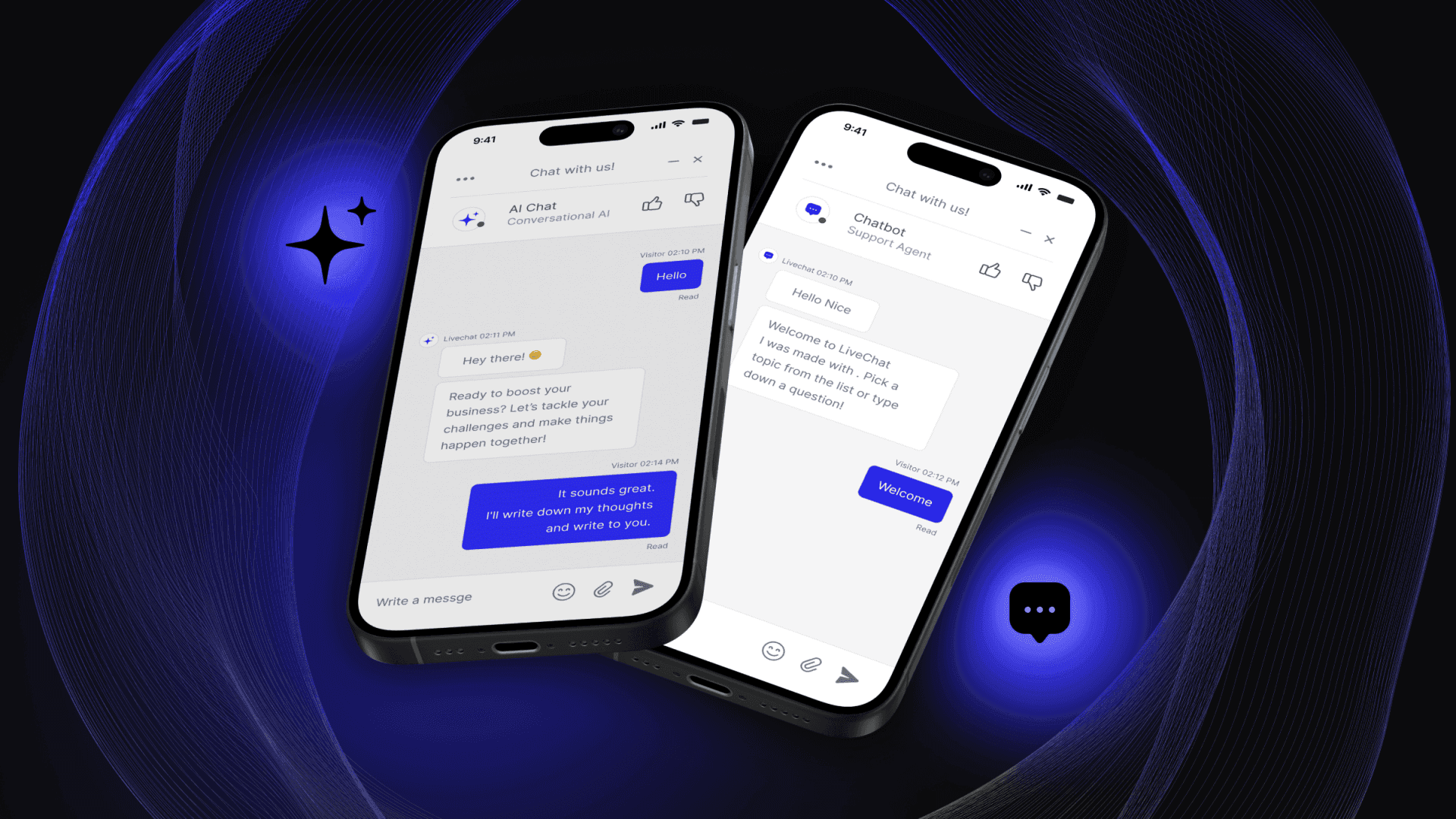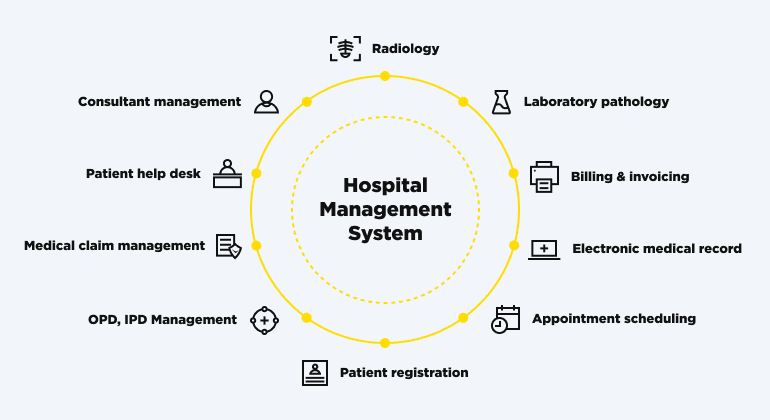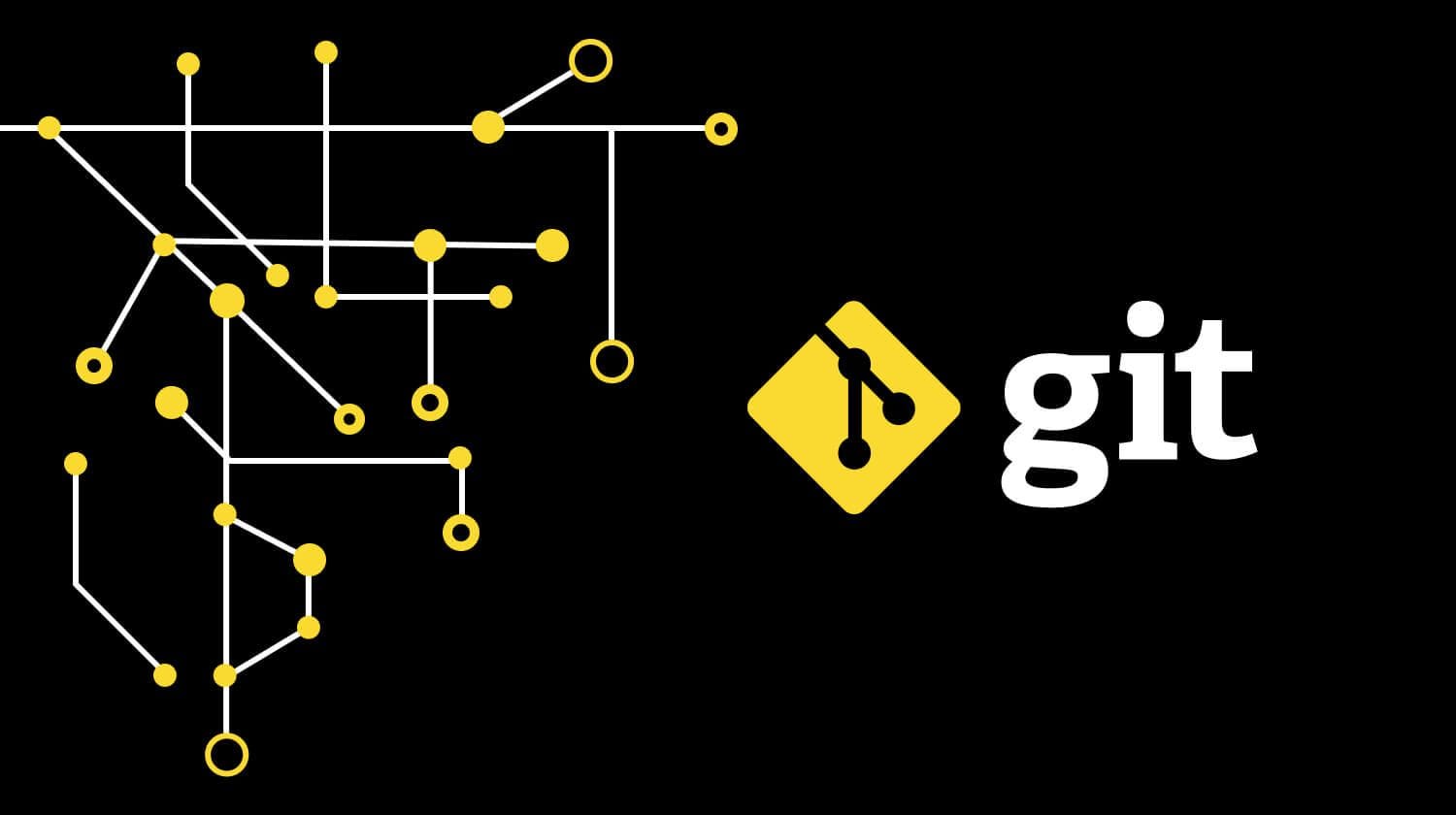The way companies provide services has significantly changed over the recent decade. All digital products (or most of them) involve various AI solutions to optimize their productivity. Should we be bothered by that? Of course not! All these solutions come into play only to simplify and improve customer service.
What are the most common examples of such developments? We would say that conversational AI assistants are the most commonly used by companies. In this matter, people often think of chatbots vs. conversational AI. It is essential to note that they are often lumped together, however, they’re not the same thing. Do they have some similarities? Sure, both solutions help businesses automate interactions. Nevertheless, the way they work and the experiences they deliver are completely different. We bet you’ve noticed these differences when intersecting with some super rigid bits and others that seem almost human.
If you’re willing to learn more about the differences between chatbots and conversational AI solutions, you’re in the right place. We’ll break down the key differences between traditional and conversational chatbots and explore their capabilities, use cases, and benefits. As a result, you should find it easier to decide which solution best fits your needs and business goals.
Defining the Concept of a Chatbot
Before we dive into differences, let’s define a chatbot. It is an automated tool designed to simulate human conversations with your users. It is better to imagine them as digital assistants that follow specific rules to answer questions, help with simple or routine tasks, and guide users through a process (orders, refunds, scheduling, etc.).
What Are the Most Common Types of Chatbots?
To better understand chatbots, it is crucial to explore their main types. Let’s dive into that!
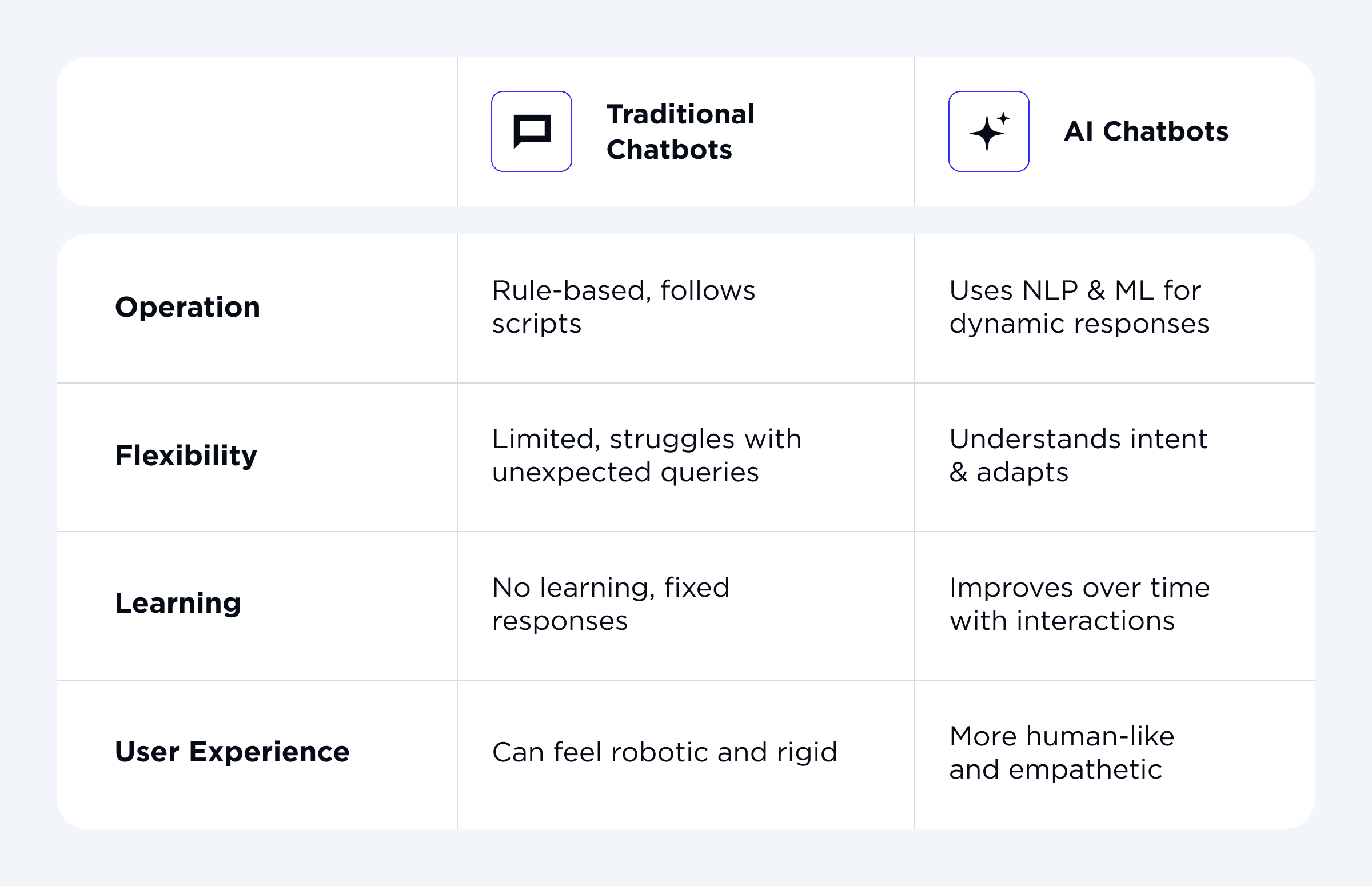
Traditional chatbots
When speaking of traditional chatbots, their purpose is to operate on a rule-based system. What does it imply? There is a structured script (or algorithm), which they follow. Consequently, they can easily handle some predictable or repetitive questions. In most cases, these bots use decision trees, which means they’re programmed with a set of possible questions and pre-written answers. There is a downside of such chatbots, as when a customer asks something that falls outside this predefined structure, the bot struggles to respond effectively (that is when you start receiving some obscure answers).
What could be an example of a traditional chatbot? Imagine you enter a retail chatbot, and you want to check the status of your order. This chatbot may ask you something like, “What’s your order number?” If you answer accordingly, the chatbot will be able to provide information on your order status. However, if you ask something out of the ordinary (or something that is not pre-programmed), like, “Can I change my shipping address?”, a chatbot might hit a dead end.
AI chatbots
If it is okay to say so, we’d call AI-powered chatbots more intelligent. These AI chatbots take automation a step further. Their more advanced work is possible thanks to natural language processing (NLP) and machine learning (ML). These technologies make it manageable for chatbots to understand user intent and the context of the conversation. Moreover, they can learn from all human interactions and improve over time.
Let’s imagine an example of such an AI-based chatbot. Going back to our retail store website, you’ve learned the status of your order, and now you know that the delivery is expected 2 days later than you thought. You may get frustrated, and this chatbot can recognize a change in your tone. As a result, it can start responding with a more empathetic approach. Now, sure, it will help you, but at least it doesn’t get stuck. This is where professional AI chatbot development
comes into play, building chatbots that are truly adaptive, intelligent, and tailored to your business needs.
What Are the Examples of a Chatbot?
We’ve already discussed some imaginary examples of rule-based chatbots. It is crucial to mention that traditional chatbots are widely used across industries and companies. Let’s find out some real-world examples.
#1 Lufthansa Airline Chatbot (Mildred)
This common chatbot was created to help users find the cheapest flights. What are the examples of interactions you may have with this solution?
The user asks, “What’s the cheapest flight from Berlin to Paris next Saturday?”
Mildred answers, “The lowest flight from Berlin to Paris on Saturday is €89. Would you like to book now?”
#2 Bank of America’s Chatbot (Erica’s early versions)
Nowadays, they use an enhanced AI solution. However, in the beginning, they involved a traditional chatbot. How did it behave?
The user inputs, “How much money do I have in my banking account?”
Erica answers, “Your banking account balance is $1,245.60.”
#3 Walmart's Automated FAQ Chatbot
Walmart store has a rather basic chatbot with conversational interfaces on its website to help customers with common questions (store hours, return policies, order tracking, etc.). What is an example of an interaction?
The user asks, “What is your return policy?”
Chatbot answers, “Most items can be returned within 90 days with a receipt. Would you like more details?”
#4 Domino’s Pizza Chatbot (Dom)
Domino’s “Dom” is a chatbot that allows users to place an order via Facebook Messenger or the website. It can, if needed, send you to human agents for deeper conversations. How can users interact with it?
The user says, “I want to order a pepperoni pizza.”
Dom answers, “Would you like a medium or large pepperoni pizza?”
As you can see, these are simple and basic chatbots. However, they still help you optimize the use of human resources and boost your company’s productivity.
How Do You Define Conversational AI?
As you might have already understood, conversational AI is like the next-level chatbot. There are top-notch technologies that are involved in the development of these solutions, like NLP, machine learning models, and speech recognition, which create much smoother and more natural chats. Using these chats, you can be sure that they not only follow the pre-defined scripts, but also get the conversation flow, and tone of voice, remember previously said information, and even adjust their responses. Altogether, it makes it possible to keep things real and accurate.
What Are the Most Common Types of Conversational AI?
It is not just one-type-fits-all. Conversational AI solutions have different types. Let’s explore them.
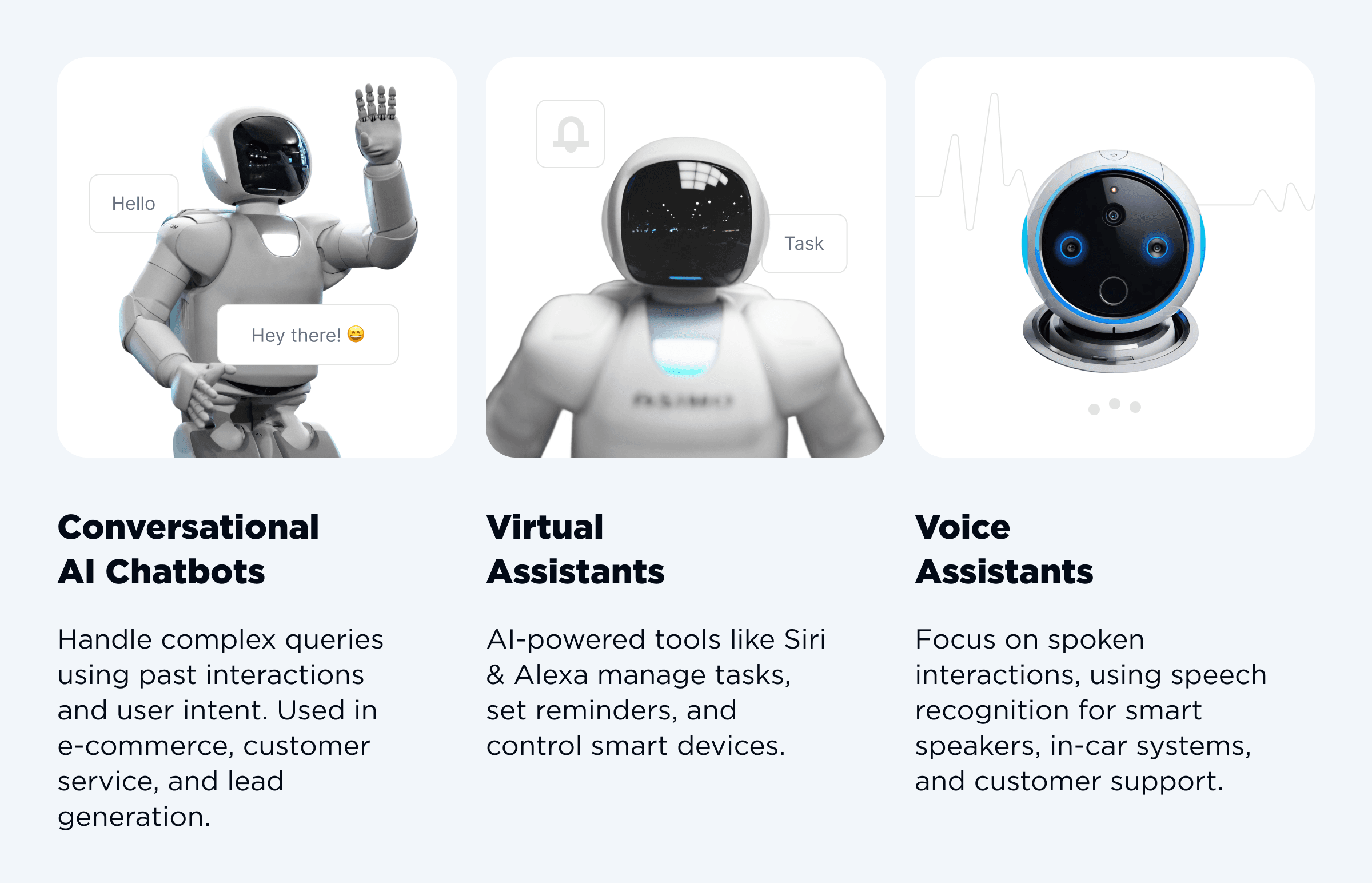
Conversational AI chatbots
These chatbots create meaningful dialogues with your customers. They can easily handle complex queries. It is feasible due to their ability to analyze past interactions and user intent. The industries that commonly use such chatbots are e-commerce, customer service, and lead generation.
Virtual assistants
You’ve already interacted with such virtual agents. For example, Siri, Google Assistant, and Alexa are artificial intelligence solutions that take AI chatbots to the next level. Software developers can integrate them with multiple applications. What can users do with them? Set reminders, check calendars, or control smart home devices. Moreover, this type of interaction can also involve voice commands or image recognition.
Voice assistants
As a separate type of conversational AI, voice assistants focus on spoken language interactions. These solutions are very inclusive and accurate. They rely on advanced speech recognition and NLP technologies and can process and respond to verbal commands. The most popular examples include smart speakers, in-car assistants, and voice-controlled customer support systems.
What Are the Examples of Conversational AI?
The best way to better understand and imagine smart AI assistants is to get acquainted with some real examples. That’s what we've prepared for you on the list below.
#1 Customer support chatbot
For example, H&M uses a virtual assistant for various customer requests. Their users can get updates on product availability, returns, and more 24/7.
#2 E-commerce personalization assist
One of the most famous and commonly used examples is Sephora's Virtual Artist. It lets users try makeup virtually using AI. They also have a chatbot to assist customers with product recommendations (it analyzes their preferences, behavior, and past purchases).
#3 Banking and finance AI assistants
As previously mentioned, Bank of America owns Erica, which is a digital assistant that helps customers check balances, transfer funds, pay bills, and even get insights into their spending habits. This is a new AI-powered version.
#4 Education and learning solutions
Many people use Duolingo. But how many people are aware that it uses conversational AI? The main purpose of it is to engage users in interactive conversations, correct their mistakes in real-time, and offer personalized experiences.
#5 HR and recruiting AI assistance
There’s a growing demand for Mya, which is an AI recruiter. It engages with candidates through chat, screening resumes, and conducting initial interviews. This is a great solution for large businesses that can optimize their human resources for more high-value tasks.
These are just a few examples of conversational AI. There are other applications of this solution in the automotive industry, smart homes, retail, healthcare, and many more.
What Are The Main Differences Between Chatbots and Conversational AI?
Considering the previously mentioned information, you may have already reached a conclusion on the main differences between traditional chatbots vs. conversational AI. However, let us summarize the distinct differences.
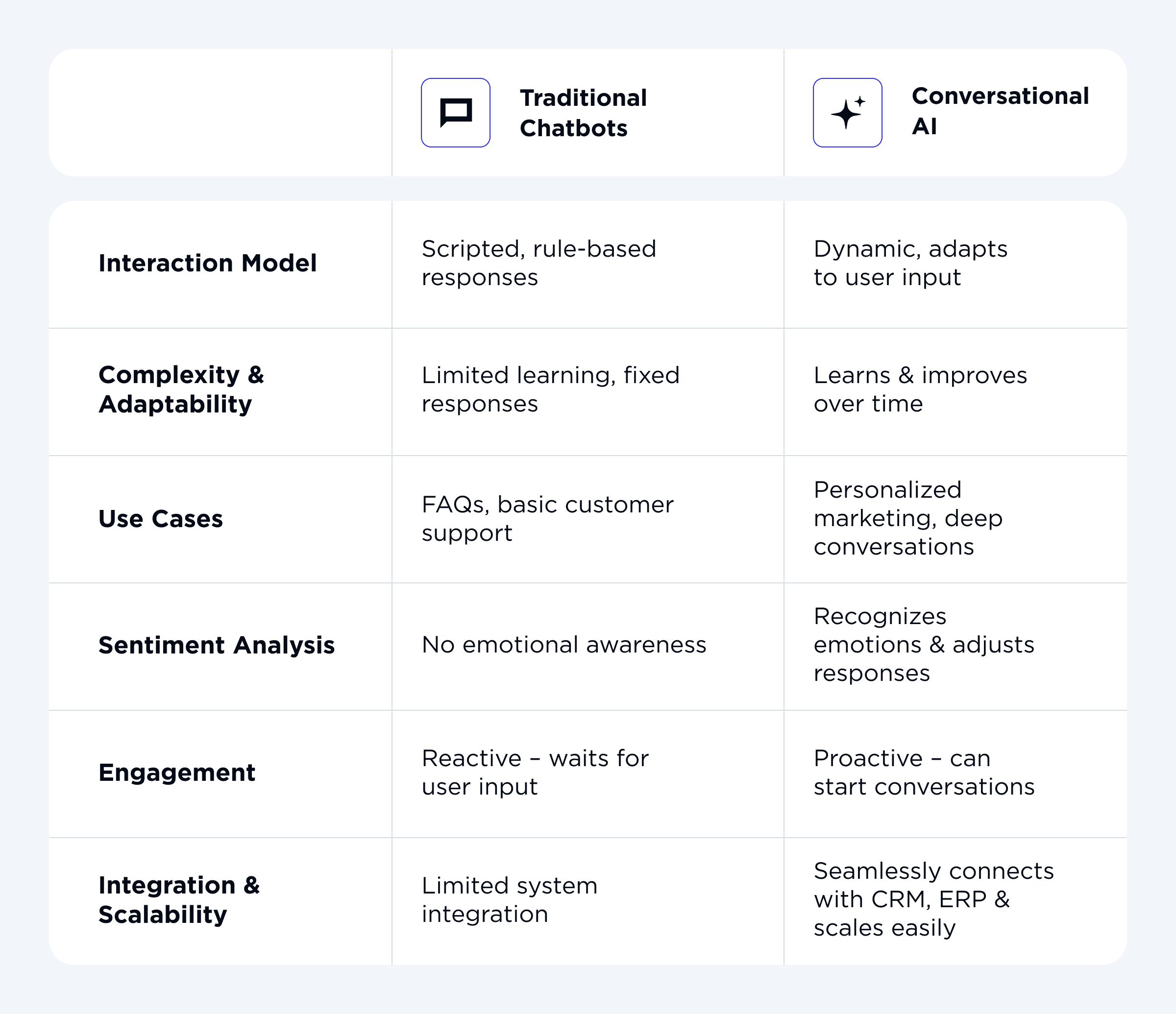
Interaction model: scripted vs. dynamic responses
While traditional chatbots stick to their scripts, conversational AI is more like a skilled improviser. These cost-effective solutions can adapt and respond dynamically to customers’ input.
Complexity and adaptability
Сonversational AI is like a chatbot that learns and grows. Over time, it gets better at understanding your customers. As a result, it leads to enhanced customer satisfaction.
Use cases and applications
If you need a tool to answer FAQs and boost response times effectively, choose traditional chatbots. However, if you need options for personalized marketing and deep and engaging dialogues, opt for conversational AI.
Sentiment analysis and emotional responsiveness
Consider conversational AI your friend who knows when you're upset. This way it can adapt to your mood and know how to talk to you. What about chatbots? They will likely just stick to their scripts, no matter your mood.
Proactive engagement and personalized messaging
Both chatbots and conversation AI are tailor-made for engaging messaging. However, unlike chatbots, conversational AI can even start a conversation based on what it knows about you. At the same time, traditional chatbots are just waiting for you to come to them.
Integration with business systems and scalability
If you need a solution that will connect seamlessly with your CRM, ERP, and other systems, choose conversational AI. It is important to note that chatbots are a bit isolated and don’t scale so well.
Chatbots vs. Conversational AI: Which One’s Right for You?
It might be challenging to choose the right options. So, let’s find out the cases when one is right for you.
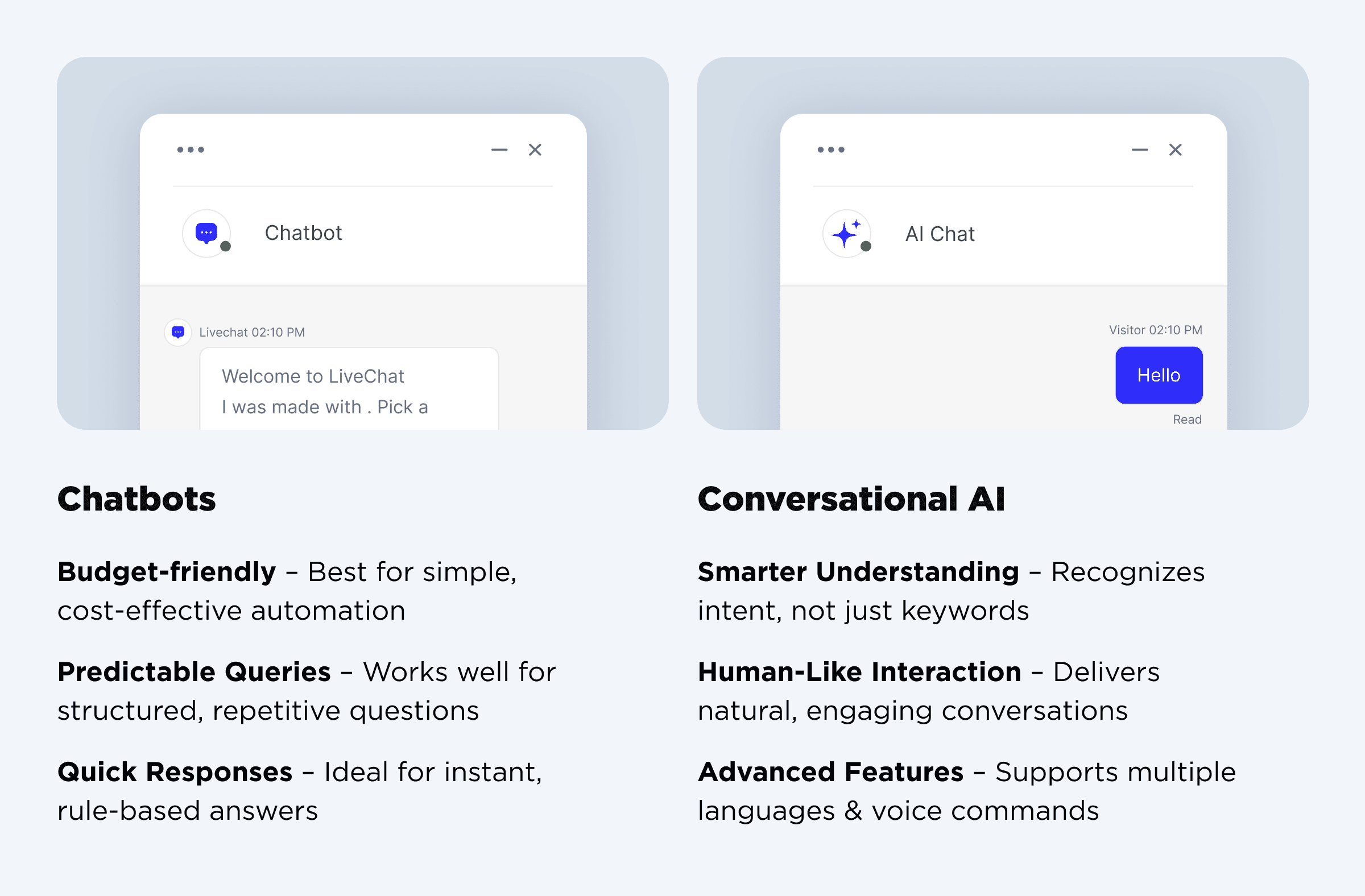
When should you go for a chatbot?
#1 You want something simple and budget-friendly for answering FAQs.
#2 Your customer queries are pretty predictable and follow a clear pattern.
#3 You just need quick, automated responses (no need to get too technical).
When should you go for a conversational AI?
#1 You need something smarter to understand what people actually mean (not just what they say by a pre-programmed algorithm).
#2 Your customers expect a more natural, engaging chat (in other words - you need something more human).
#3 You need extra features like speaking multiple languages or using voice commands.
Wrapping up, depending on your needs, preferences, type of business, budget, and other factors, you may decide what option works best for you. We do recommend you contact an experienced team to get a consultation about chatbots and conversation AI and help you figure out what option to choose.
What Are The Reasons Why Conversational AI Beats Traditional Chatbots?
No matter how much we try to be neutral, there are too many reasons to consider conversational AI to be better than traditional one. Here’re the benefits that make it so!
Smarter language understanding
Due to the more advanced technologies involved, conversational AI gets what your customers are really saying. This leads to reducing any misunderstandings and making customer interactions feel more natural.
Enhanced remembering and learning from past chats
In contrast to basic chatbots, conversational AI keeps track of previous conversations. As a result, it can offer more personalized and accurate responses over time, leading to a better customer experience.
Handling multiple requests at once
Do you need to make it possible for your customers to ask a few things in one go? Here you go! That is what conversational AI can handle! Multi-intent cognition is their substantial benefit over traditional chatbots.
Seamless integration into your systems and growth opportunities
Usually, both chatbots and conversational AI easily plug into your existing business systems. However, with conversational solutions, you get smooth data flow, accuracy, and consistency and significantly boost operational efficiency. Moreover, these tools grow with your business and are super scalable.
Global reach with multilingual options and voice assistance
Multiple language and voice assistance are rather essential reasons to choose conversational AI over a traditional chatbot. You can reach a global audience and people who speak different languages. Moreover, many customers prefer voice commands, and conversational AI can adapt to that too. It is a perfect fit for business owners planning to go global (or planning to do so).

Get your advanced AI assistant!
GET STARTEDWhat Can We Expect From Chatbots vs. Conversational AI In The Future?
There’s no denying that the future is moving toward more human-like AI interactions. All these technologies, developments in AI, deep learning, and natural language understanding, are taking us closer to the present with a bridge between human language and machine communication.
But what can we wait for in the future in terms of chatbots and conversational AI? In our humble opinion, we can expect the following:
#1 Traditional chatbots will still follow scripts (it is likely they will not be so widely used)
#2 Conversational AI will sound even more human
#3 AI solutions will handle the boring and simple tasks (it will free up space for humans to do more high-value tasks)
#4 Services will feel more personal (generative AI solutions will remember all your preferences)
#5 You’ll talk to AI everywhere (let’s be honest, we should expect them to be everywhere, websites, apps, smart devices, even in-store kiosks)
Advanced Chatbots and Conversational AI: How OTAKOYI Can Help
Our team at OTAKOYI specializes in building intelligent AI-driven chatbots and conversational AI solutions. We aim to create tailored products that align with your business needs. If you need either a simple chatbot or an advanced AI-powered assistant, our team is here for you!
What do we offer?
#1 Custom AI that fits your business
To be honest, we don’t believe in one-size-fits-all. That is why our solutions are tailored to work perfectly for your needs specifically.
#2 Chatbots that do more
Not just for FAQs! Let’s aim higher! We create chatbots for a whole range of tasks.
#3 AI that gets smarter over time
The more your customers interact, the better your chatbot becomes. Scalable and functional solutions!
#4 Human-like assistants
We strive to build an AI assistant that feels personal. If you want your customers actually to enjoy interacting with it, you’ve reached the right address.
#5 Fast, easy integration
No need to hassle! We make it simple to integrate our AI into your existing systems. No headaches, just powerful solutions!
